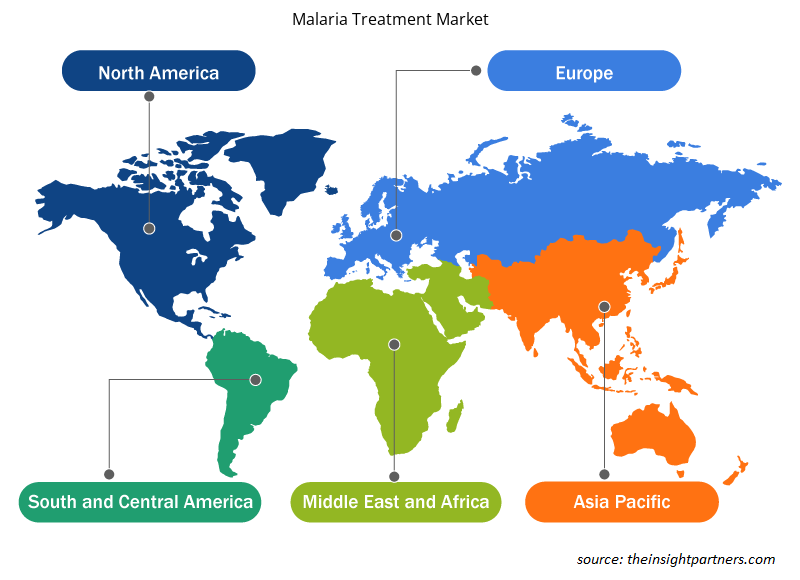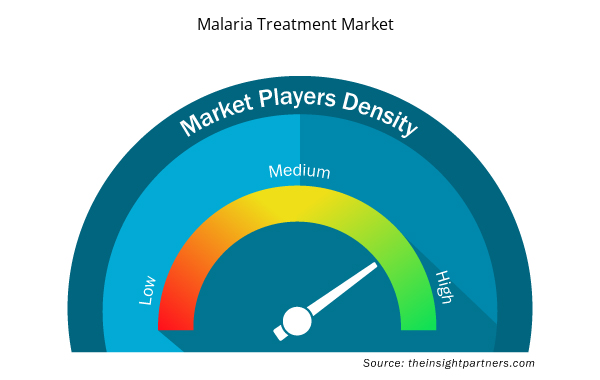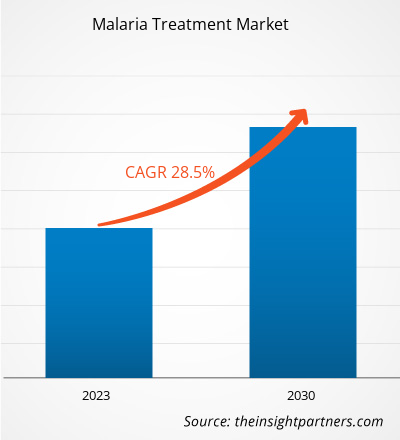[研究报告] 2022年疟疾治疗市场价值为 32.9698 亿美元,预计到 2030 年将达到 244.8773 亿美元;预计 2022 年至 2030 年的复合年增长率为 28.5%。
市场洞察和分析师观点:
疟疾是一种由疟原虫引起的危及生命的传染病。由于低收入国家疟疾患病率高,以及国际和国家组织发起的全球疟疾消除计划,疟疾治疗市场正在增长。此外,先进诊断工具的不断推出和为提供有效治疗方法而开展的研究活动的不断增加,正在推动疟疾治疗市场的增长。在大流行的两个高峰年(2020-2021 年),与 COVID 相关的干扰导致超过 1300 万例疟疾病例和 63,000 例相关死亡。世卫组织非洲区域继续承担着全球疟疾负担的巨大份额。2021 年,非洲约占所有疟疾病例的 95% 和死亡人数的 96%。此外,5 岁以下儿童占该地区所有疟疾死亡人数的约 80%。据同一消息来源称,尼日利亚、刚果民主共和国、坦桑尼亚联合共和国和尼日尔占全球疟疾死亡人数的一半以上。
增长动力和挑战:
疟疾是一种急性发热性疾病,由疟原虫引起,通过受感染的雌性按蚊传播。人类主要有五种寄生虫导致疟疾,其中两种——恶性疟原虫和间日疟原虫——被认为是对人类健康的最大威胁。此外,恶性疟原虫是最致命的疟疾寄生虫,在非洲大陆传播最为广泛。此外,间日疟原虫是撒哈拉以南非洲以外大多数国家的主要疟疾寄生虫。根据世界卫生组织 (WHO) 最新的《2020 年世界疟疾报告》(WMR),全球报告了 2.41 亿例疟疾病例,而 2019 年记录的病例为 2.27 亿例。根据同一来源,疟疾造成的死亡人数每年增加 69,000 人。其中约三分之二(即 47,000 人)的死亡是由于 COVID-19 疫情期间医疗服务中断造成的;其余三分之一(即 22,000 人)的死亡反映了世卫组织计算疟疾死亡率的方法最近发生了变化(不考虑 COVID-19 中断)。因此,全球不同地区疟疾患病率的上升推动了疟疾治疗市场的增长。
抗疟药物耐药性的发生可能是由于假药的供应和使用日益增多、某些预防药物的过度使用、活动性感染的治疗不彻底以及疟原虫在遗传和代谢水平上的适应性等原因造成的。假冒抗疟药物的使用增多是全球医疗保健部门面临的主要问题。由于医疗成本高昂,大多数非洲国家都广泛使用假冒抗疟药物。人们还选择使用假药以更低的成本接受治疗,而一些国家缺乏合理的质量控制和验证流程,从而为获取这些假药提供了便利。根据《媒介传播疾病杂志 2020》报道,假冒抗疟药物不仅造成经济损失,还降低了治疗效果,从而导致人们对医疗保健系统失去信心,并增加了疟原虫产生耐药性的可能性。
因此,假冒抗疟药的日益盛行阻碍了疟疾治疗市场的增长。
定制此报告以满足您的需求
您可以免费定制任何报告,包括本报告的部分内容、国家级分析、Excel 数据包,以及为初创企业和大学提供优惠和折扣
- 获取此报告的关键市场趋势。这个免费样品将包括数据分析,从市场趋势到估计和预测。
报告细分和范围:
根据治疗方法,疟疾治疗市场细分为仿制药、原研药、疫苗和其他。根据给药途径,疟疾治疗市场分为口服和肠外给药。根据分销渠道,疟疾治疗市场细分为直接招标、医院药房、零售药房、网上药房和其他。按地域划分,疟疾治疗市场细分为北美(美国、加拿大和墨西哥)、欧洲(英国、德国、法国、意大利、西班牙和欧洲其他地区)、亚太地区(中国、日本、印度、澳大利亚、韩国和亚太其他地区)、中东和非洲(沙特阿拉伯、阿联酋、南非、肯尼亚、坦桑尼亚、卢旺达、尼日利亚、加纳、乌干达、安哥拉、喀麦隆、塞内加尔、赞比亚和中东和非洲其他地区)以及南美洲和中美洲(巴西、阿根廷和南美洲和中美洲其他地区)。
节段分析:
根据治疗方法,疟疾治疗市场细分为仿制药、原创药物、疫苗和其他。2022 年,疫苗细分市场占据了最大的市场份额。此外,预计该细分市场在预测期内的复合年增长率最高。疫苗提供针对特定传染病的主动获得性免疫。由于研发活动不断增加以及候选疫苗渠道不断增加,疟疾疫苗市场正在以显着的速度增长。唯一获批的疟疾疫苗是葛兰素史克开发的 RTS,S 疫苗,用于防止恶性疟原虫进入肝脏。它需要注射四次,并通过撒哈拉以南非洲国家的国家免疫计划提供给幼儿。该疫苗是 2019 年开始的试点引入的一部分。国际和地方合作是疫苗开发不可或缺的一部分,到 2024 年试点推广结束时; RTS,S 的资助预计将超过 10 亿美元,其中 7 亿美元将由葛兰素史克公司提供,该公司已为该试点项目捐赠了 1000 万剂疫苗。
按给药途径,疟疾治疗市场分为口服和肠外给药。2022 年,口服部分占据了更大的市场份额。然而,预计肠外部分在预测期内的复合年增长率会更高。口服给药是最优选和最合适的给药途径,因为它具有较高的患者依从性、非侵入性、最少的无菌限制、成本效益、剂型设计的灵活性和制造过程的简易性。易于给药和长期成本效益等优势是推动口服药物采用的主要因素。药片、胶囊和其他口服药物的低制造成本也是疟疾治疗市场增长的关键驱动因素。一些可用的抗疟疾药物是奎宁、奎尼丁、氯喹、阿莫地喹、他非诺喹氯胍、氯丙胍和青蒿素。 ACT 和联合疗法用于治疗由恶性疟原虫引起的无并发症疟疾。ACT 是目前市场上最有效的抗疟药物。
根据分销渠道,疟疾治疗市场分为直接招标、医院药房、零售药房、在线药房和其他。2022 年,直接招标部分占据了最大的市场份额。此外,预计同一部分在预测期内也将录得最高的复合年增长率。招标是执行特定任务或以固定金额提供物品的要约。在此招标程序的第一步中,将要求承包商提交密封的施工投标或在特定期限内提供特别计划的服务或产品。印度的电子招标程序旨在确保及时完成政府或特定客户的工作。例如,一些地方可能有特定的采购法规,规定决策方式和接受哪些投标。例如,全印度医学科学院、比哈尔邦医疗服务和基础设施有限公司(比哈尔邦政府)、巴特那(AIIMS Patna)董事总经理邀请知名、经验丰富、财力雄厚的公司/企业/机构为印度不同的医疗机构竞标疟疾检测试剂盒和药物。
区域分析:
根据地理位置,疟疾治疗市场分为五个主要区域——北美、欧洲、亚太地区、南美和中美以及中东和非洲。北美市场的分析主要集中在三个主要国家——美国、加拿大和墨西哥。2022 年,中东和非洲占据了疟疾治疗市场的最大份额。可支配收入的增加、对有针对性的营养的需求不断增长以及对疟疾治疗和补充剂的认识不断提高是推动市场增长的一些主要因素。
尼日利亚的疟疾治疗市场占有最大的市场份额,沙特阿拉伯是预测期内增长最快的市场。根据严重疟疾观察站的报告,疟疾在尼日利亚非常突出,约 97% 的人口患疟疾的风险很高。此外,根据 2021 年世界疟疾报告,尼日利亚记录的疟疾病例数最多,死亡人数也最多,即 2020 年全球疟疾死亡人数的约 32% 发生在该国。为了克服如此高的疟疾流行率,尼日利亚与国家疟疾消除计划 (NMEP) 合作,在世卫组织的技术支持下启动了高负担高影响 (HBHI) 方法。
疟疾治疗市场机会:
市场参与者不断增加的战略举措
疟疾治疗市场中的一些主要参与者越来越注重采用各种策略,例如产品创新、发布和批准;研发投资;以及并购,以保持竞争力。下面提到了其中一些举措:
- 2022 年 3 月,用于治疗特定疟疾菌株的新型药物他非诺喹在澳大利亚获得疟疾药物研发基金会 (MMV) 的许可,该基金会与葛兰素史克 (GSK) 共同开发了这种用于儿童和青少年的药物。该药物与广泛使用的抗疟药氯喹结合使用。
- 2021 年 12 月,Zydus Cadila 宣布计划与 Medicines for Malaria Venture 合作开发其抗疟药 ZY19489,该药物已获得美国 FDA 批准。据该公司称,ZY19489 的 I 期试验表明,该药物半衰期较长,并且有可能单剂量治愈疟疾。在另一项疟疾挑战试验中,单次口服 ZY19489 后显示出强大的抗疟活性。
因此,市场参与者上述战略举措预计将为未来几年的疟疾治疗市场提供增长机会。
疟疾治疗市场区域洞察
Insight Partners 的分析师已详细解释了预测期内影响疟疾治疗市场的区域趋势和因素。本节还讨论了北美、欧洲、亚太地区、中东和非洲以及南美和中美洲的疟疾治疗市场细分和地理位置。

- 获取疟疾治疗市场的区域特定数据
疟疾治疗市场报告范围
| 报告属性 | 细节 |
|---|---|
| 2022 年市场规模 | 33亿美元 |
| 2030 年市场规模 | 244.9亿美元 |
| 全球复合年增长率(2022 - 2030 年) | 28.5% |
| 史料 | 2020-2021 |
| 预测期 | 2023-2030 |
| 涵盖的领域 | 按治疗
|
| 覆盖地区和国家 | 北美
|
| 市场领导者和主要公司简介 |
|
疟疾治疗市场参与者密度:了解其对业务动态的影响
疟疾治疗市场正在快速增长,这得益于终端用户需求的不断增长,而这些需求又源于消费者偏好的不断变化、技术进步以及对产品优势的认识不断提高等因素。随着需求的增加,企业正在扩大其产品范围,进行创新以满足消费者的需求,并利用新兴趋势,从而进一步推动市场增长。
市场参与者密度是指在特定市场或行业内运营的企业或公司的分布情况。它表明在给定市场空间中,相对于其规模或总市场价值,有多少竞争对手(市场参与者)存在。
在疟疾治疗市场运营的主要公司有:
- 西普拉有限公司
- 辉瑞公司
- 太阳制药工业有限公司
- 赛诺菲公司。
- 葛兰素史克公司
免责声明:上面列出的公司没有按照任何特定顺序排列。

- 了解疟疾治疗市场顶级关键参与者概况
竞争格局和重点公司:
全球疟疾治疗市场中的一些知名参与者包括 Cipla Ltd、Sun Pharmaceutical Industries Ltd、Sanofi SA、GSK Plc、Novartis AG、Pfizer Inc、Emmaus Life Sciences Inc、AdvaCare Pharma USA LLC、VLP Therapeutics LLC、Lupin Ltd 和 Teva Pharmaceutical Industries Ltd。这些公司专注于开发新技术、改进现有产品和扩大地理覆盖范围,以满足全球不断增长的消费者需求并扩大其专业产品组合范围。在全球疟疾治疗市场运营的公司正在实施各种无机和有机战略。下面提到了其中一些:
- 2022 年 11 月,诺华和抗疟药物研发基金会 (MMV) 宣布决定进入 3 期临床试验,研究一种新型非青蒿素组合药物,用于治疗无并发症的疟疾。这种新型组合药物还含有优化的卢米凡特林配方,可每天给药一次,而不是通常的每天给药两次。
- 2021 年 10 月,葛兰素史克公司 (GSK) 欢迎世卫组织建议更广泛地部署 GSK 的 RTS,S 疟疾疫苗,以减少儿童(生活在撒哈拉以南非洲和其他中度至高度传播地区)因疟疾而发病和死亡的人数。RTS,S 是第一个也是唯一一个在关键长期临床试验中被证明可以显著减少儿童疟疾发病率的疟疾疫苗。该疫苗是 GSK 与 PATH 和其他合作伙伴共同领导的 30 多年研究的成果。
- 历史分析(2 年)、基准年、预测(7 年)及复合年增长率
- PEST 和 SWOT 分析
- 市场规模价值/数量 - 全球、区域、国家
- 行业和竞争格局
- Excel 数据集



Report Coverage
Revenue forecast, Company Analysis, Industry landscape, Growth factors, and Trends

Segment Covered
This text is related
to segments covered.

Regional Scope
North America, Europe, Asia Pacific, Middle East & Africa, South & Central America

Country Scope
This text is related
to country scope.
常见问题
increasing prevalence of malaria and government and private sector's initiative to raise awareness about malaria are the most significant factors responsible for the overall market growth.
Cipla Ltd, Pfizer Inc, Sun Pharmaceutical Industries Ltd, Sanofi SA., GSK Plc, Novartis AG, Pfizer Inc, AdvaCare Pharma USA LLC, VLP Therapeutics LLC, Lupin Ltd among others are among the leading companies operating in the malaria treatment market.
Malaria treatment market is segmented by countries comprising of North America, Europe, Asia Pacific, the Middle East & Africa, and South & Central America.
The direct tender segment dominated the malaria treatment market and accounted for the largest market share in 2022.
Based on route of administration, the oral segment took the forefront leaders in the worldwide market by accounting largest share in 2022 and is expected to continue to do so till the forecast period.
Malaria is a serious infection spread by an infected mosquito. The infection is very common in certain parts of the world, such as large areas of Africa and Asia, Central and South America, and the Dominican Republic and Haiti. However, malaria is an entirely preventable and treatable disease if tackled at an early stage. For example, malaria is treated with a prescription drug to kill the parasite. The types of drugs and the length of treatment vary depending on the type of malarial parasite infection, the severity of symptoms, and age.
Malaria is a serious infection spread by an infected mosquito. The infection is very common in certain parts of the world, such as large areas of Africa and Asia, Central and South America, and the Dominican Republic and Haiti. However, malaria is an entirely preventable and treatable disease if tackled at an early stage. For example, malaria is treated with a prescription drug to kill the parasite. The types of drugs and the length of treatment vary depending on the type of malarial parasite infection, the severity of symptoms, and age.
The vaccines segment dominated the malaria treatment market and accounted for the largest market share in 2022.
Trends and growth analysis reports related to Life Sciences : READ MORE..
The List of Companies - Malaria Treatment Market
- Cipla Ltd
- Pfizer Inc
- Sun Pharmaceutical Industries Ltd
- Sanofi SA.
- GSK Plc
- Novartis AG
- Pfizer Inc
- AdvaCare Pharma USA LLC
- VLP Therapeutics LLC
- Lupin Ltd
The Insight Partners performs research in 4 major stages: Data Collection & Secondary Research, Primary Research, Data Analysis and Data Triangulation & Final Review.
- Data Collection and Secondary Research:
As a market research and consulting firm operating from a decade, we have published and advised several client across the globe. First step for any study will start with an assessment of currently available data and insights from existing reports. Further, historical and current market information is collected from Investor Presentations, Annual Reports, SEC Filings, etc., and other information related to company’s performance and market positioning are gathered from Paid Databases (Factiva, Hoovers, and Reuters) and various other publications available in public domain.
Several associations trade associates, technical forums, institutes, societies and organization are accessed to gain technical as well as market related insights through their publications such as research papers, blogs and press releases related to the studies are referred to get cues about the market. Further, white papers, journals, magazines, and other news articles published in last 3 years are scrutinized and analyzed to understand the current market trends.
- Primary Research:
The primarily interview analysis comprise of data obtained from industry participants interview and answers to survey questions gathered by in-house primary team.
For primary research, interviews are conducted with industry experts/CEOs/Marketing Managers/VPs/Subject Matter Experts from both demand and supply side to get a 360-degree view of the market. The primary team conducts several interviews based on the complexity of the markets to understand the various market trends and dynamics which makes research more credible and precise.
A typical research interview fulfils the following functions:
- Provides first-hand information on the market size, market trends, growth trends, competitive landscape, and outlook
- Validates and strengthens in-house secondary research findings
- Develops the analysis team’s expertise and market understanding
Primary research involves email interactions and telephone interviews for each market, category, segment, and sub-segment across geographies. The participants who typically take part in such a process include, but are not limited to:
- Industry participants: VPs, business development managers, market intelligence managers and national sales managers
- Outside experts: Valuation experts, research analysts and key opinion leaders specializing in the electronics and semiconductor industry.
Below is the breakup of our primary respondents by company, designation, and region:

Once we receive the confirmation from primary research sources or primary respondents, we finalize the base year market estimation and forecast the data as per the macroeconomic and microeconomic factors assessed during data collection.
- Data Analysis:
Once data is validated through both secondary as well as primary respondents, we finalize the market estimations by hypothesis formulation and factor analysis at regional and country level.
- Macro-Economic Factor Analysis:
We analyse macroeconomic indicators such the gross domestic product (GDP), increase in the demand for goods and services across industries, technological advancement, regional economic growth, governmental policies, the influence of COVID-19, PEST analysis, and other aspects. This analysis aids in setting benchmarks for various nations/regions and approximating market splits. Additionally, the general trend of the aforementioned components aid in determining the market's development possibilities.
- Country Level Data:
Various factors that are especially aligned to the country are taken into account to determine the market size for a certain area and country, including the presence of vendors, such as headquarters and offices, the country's GDP, demand patterns, and industry growth. To comprehend the market dynamics for the nation, a number of growth variables, inhibitors, application areas, and current market trends are researched. The aforementioned elements aid in determining the country's overall market's growth potential.
- Company Profile:
The “Table of Contents” is formulated by listing and analyzing more than 25 - 30 companies operating in the market ecosystem across geographies. However, we profile only 10 companies as a standard practice in our syndicate reports. These 10 companies comprise leading, emerging, and regional players. Nonetheless, our analysis is not restricted to the 10 listed companies, we also analyze other companies present in the market to develop a holistic view and understand the prevailing trends. The “Company Profiles” section in the report covers key facts, business description, products & services, financial information, SWOT analysis, and key developments. The financial information presented is extracted from the annual reports and official documents of the publicly listed companies. Upon collecting the information for the sections of respective companies, we verify them via various primary sources and then compile the data in respective company profiles. The company level information helps us in deriving the base number as well as in forecasting the market size.
- Developing Base Number:
Aggregation of sales statistics (2020-2022) and macro-economic factor, and other secondary and primary research insights are utilized to arrive at base number and related market shares for 2022. The data gaps are identified in this step and relevant market data is analyzed, collected from paid primary interviews or databases. On finalizing the base year market size, forecasts are developed on the basis of macro-economic, industry and market growth factors and company level analysis.
- Data Triangulation and Final Review:
The market findings and base year market size calculations are validated from supply as well as demand side. Demand side validations are based on macro-economic factor analysis and benchmarks for respective regions and countries. In case of supply side validations, revenues of major companies are estimated (in case not available) based on industry benchmark, approximate number of employees, product portfolio, and primary interviews revenues are gathered. Further revenue from target product/service segment is assessed to avoid overshooting of market statistics. In case of heavy deviations between supply and demand side values, all thes steps are repeated to achieve synchronization.
We follow an iterative model, wherein we share our research findings with Subject Matter Experts (SME’s) and Key Opinion Leaders (KOLs) until consensus view of the market is not formulated – this model negates any drastic deviation in the opinions of experts. Only validated and universally acceptable research findings are quoted in our reports.
We have important check points that we use to validate our research findings – which we call – data triangulation, where we validate the information, we generate from secondary sources with primary interviews and then we re-validate with our internal data bases and Subject matter experts. This comprehensive model enables us to deliver high quality, reliable data in shortest possible time.


 获取此报告的免费样本
获取此报告的免费样本